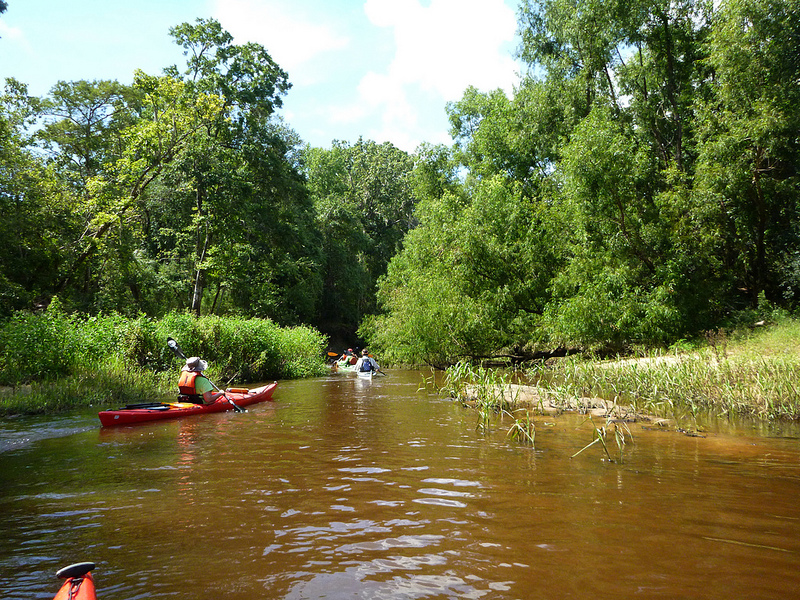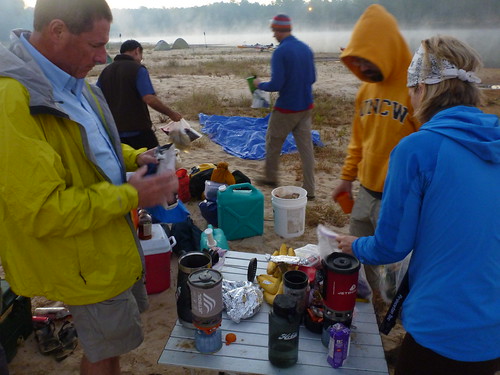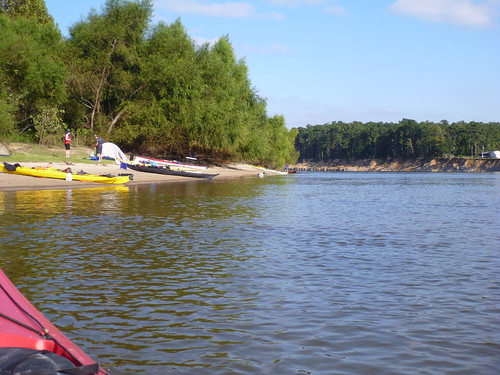The Apalachicola Blueway is managed by the Apalachicola Riverkeeper, and the trail was mapped and the Blueway Guide created by Florida DEP’s Office of Greenways and Trails.
Part 2 of the RiverTrek 2013 Adventure is now online. Witness some of the long term damage done to the river, and tag along as we take advantage of this year’s higher water to paddle into one of our area’s “quintessential” swamps. If you missed Part 1, catch it here. In 2012, we paddled the river in it’s entirety.
Rob Diaz de Villegas WFSU-TV
After having partaken in the last couple of RiverTrek paddles down the Apalachicola River, I have to commend Georgia Ackerman and Doug Alderson for the work they put in to planning the trips. A dozen paddlers of multiple experience levels paddle 107 + miles (once you factor in side trips) over five days, camping along the way. Even a relative newbie like me can tag along and find myself alive in Apalachicola five days later.
You’re in good hands having expert paddlers like Doug and Georgia in charge. But, thanks to a lot of hard work by Doug, any moderately experienced paddler has the tools to plan their own RiverTrek. Where do you camp? Where can you refill your water? On what sand bar can you have a Jetboil tea party? All of those questions are made clearer with the Apalachicola Blueway Paddling Trail guide.
Choose your adventure

The River Styx. Incorporating creeks and tributaries into your Apalachicola River adventure can give you a more intimate feel for the river.
Every year for RiverTrek, paddlers have to find a way to extricate themselves from work and family obligations for five days to paddle the entirety of the Apalachicola River. But not every trip has to eat your whole week. Consulting the handy dandy Apalachicola Blueway Trail Guide, you’ll see that there are multiple locations to put in and take out along the river.
Last year for a RiverTrek warm up paddle, I accompanied some of my fellow trekkers on a trip from the River Styx to Owl Creek. This was an 18 mile day trip that let us see a couple of side channels as well as the river itself. This year on the Trek, I was extracted at Estiffinulga after two days of paddling and one night of camping. You have a lot of options, especially if you factor in the many creeks and tributaries in the lower river, in the Apalachicola Wildlife and Environmental Area (Watch our EcoAdventure in the Apalachicola WEA).
Once you know how many days you’ll be able to spend on your trip, decide how many miles you’re able to do a day. This year, we averaged just over 20 miles a day at about 5 – 6 miles an hour, and we did 4 miles an hour with last year’s record low flows. Of course, you’ll want to make sure that there’s a place for you to sleep at the end of the day…
Camping

Breakfast on the Estiffinulga sand bar on RiverTrek 2012. Look at how big it is! The Apalachicola is full of high, wide sand bars…
In Part 1 of our video, our trip leaders found the Alum Bluff sand bar too small for sixteen campers. No problem. There was another high, wide sand bar just a mile to the north, and it wasn’t even on the trail map as a campsite. The upper Apalachicola has numerous such sand bars, which gives you flexibility in planning your trip. Once you get past Wewahitchka at mile 42 (mile markers start at 106 at the Woodruff Dam and work their way down to 0 at Apalachicola), there are less options directly on the main channel.
This year, we had some rain and the Army Corps of Engineers had more water to release from the Woodruff Dam. That means that the river rose a little overnight, and so we had to pull our kayaks a little further up on the bar. Which brings me to…
Staying high and dry

…Estiffinulga sand bar on RiverTrek 2013. For all I know, the spot where the breakfast table is in the picture above is under my kayak here. Checking the U.S. Geological Survey’s river gauges can give you an idea about how big some of these sand bars might be.
RiverTrek occurs in October every year, during the river’s low water season. The high water season begins in late February and continues through May. It’s usually lowest in the fall. This means that, typically, there are more sand bars exposed for camping then. Typically. Whereas last year, drought conditions kept the sand bars as exposed as they’ve ever been, this year’s rain has left them much smaller. That’s the beauty of the outdoors. I went on the same trip two years in a row, and things looked different in a lot of places. But how can you know what to expect when you plan your trip?
For best camping conditions, the Blueway Guide recommends that the US Geological Survey gauge at Chattahoochee remains below 44 feet, and below 5.5 feet at the USGS Sumatra gauge. Looking at the gauge info at the link above, I see that Chattahoochee was around 42.5 with a spike to 43.5 (when water is released from the dam) for the first day of RiverTrek. At that height, Alum Bluff was too small for our group and Estiffinulga sand bar (the day 2 camp site) looked nice and cozy. Within a couple of days, the gauge readings swelled to near 44 feet.
Bring all the gear you will need
The Florida Department of Environmental Protection’s Office of Greenways and Trails (where Doug works) has compiled some helpful checklists to make sure you bring everything you need for kayak camping trip. The bar on the right side of their Florida Circumnavigational Saltwater Paddling Trail web site has links to safety tips and a recommended gear list. You could also watch this short video we did with Georgia and her husband and RiverTrek alum Rick Zelznak, on packing for kayak camping. In about five minutes, they give you a quick rundown of what to bring, how to organize it in your dry bags, and how to fit it all into your kayak (this was based on Georgia’s RiverTrek 2011 experience).
Plan your route. Check the river gauges. Make sure you have all the gear you need, and that you can fit it into your kayak or canoe. Experience one of Florida’s great rivers.
We work hard on these videos, but it’s never the same as being there.
